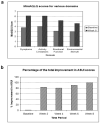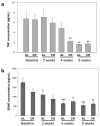Alternate day calorie restriction improves clinical findings and reduces markers of oxidative stress and inflammation in overweight adults with moderate asthma
- PMID: 17291990
- PMCID: PMC1859864
- DOI: 10.1016/j.freeradbiomed.2006.12.005
Alternate day calorie restriction improves clinical findings and reduces markers of oxidative stress and inflammation in overweight adults with moderate asthma
Erratum in
- Free Radic Biol Med. 2007 Nov 1;43(9):1348. Tellejohan, Richard [corrected to Telljohann, Richard]
Abstract
Asthma is an increasingly common disorder responsible for considerable morbidity and mortality. Although obesity is a risk factor for asthma and weight loss can improve symptoms, many patients do not adhere to low calorie diets and the impact of dietary restriction on the disease process is unknown. A study was designed to determine if overweight asthma patients would adhere to an alternate day calorie restriction (ADCR) dietary regimen, and to establish the effects of the diet on their symptoms, pulmonary function and markers of oxidative stress, and inflammation. Ten subjects with BMI>30 were maintained for 8 weeks on a dietary regimen in which they ate ad libitum every other day, while consuming less than 20% of their normal calorie intake on the intervening days. At baseline, and at designated time points during the 8-week study, asthma control, symptoms, and Quality of Life questionnaires (ACQ, ASUI, mini-AQLQ) were assessed and blood was collected for analyses of markers of general health, oxidative stress, and inflammation. Peak expiratory flow (PEF) was measured daily on awakening. Pre- and postbronchodilator spirometry was obtained at baseline and 8 weeks. Nine of the subjects adhered to the diet and lost an average of 8% of their initial weight during the study. Their asthma-related symptoms, control, and QOL improved significantly, and PEF increased significantly, within 2 weeks of diet initiation; these changes persisted for the duration of the study. Spirometry was unaffected by ADCR. Levels of serum beta-hydroxybutyrate were increased and levels of leptin were decreased on CR days, indicating a shift in energy metabolism toward utilization of fatty acids and confirming compliance with the diet. The improved clinical findings were associated with decreased levels of serum cholesterol and triglycerides, striking reductions in markers of oxidative stress (8-isoprostane, nitrotyrosine, protein carbonyls, and 4-hydroxynonenal adducts), and increased levels of the antioxidant uric acid. Indicators of inflammation, including serum tumor necrosis factor-alpha and brain-derived neurotrophic factor, were also significantly decreased by ADCR. Compliance with the ADCR diet was high, symptoms and pulmonary function improved, and oxidative stress and inflammation declined in response to the dietary intervention. These findings demonstrate rapid and sustained beneficial effects of ADCR on the underlying disease process in subjects with asthma, suggesting a novel approach for therapeutic intervention in this disorder.
Figures







References
-
- Bel EH. Clinical phenotypes of asthma. Curr Opin Pulm Med. 2004;10:44–50. - PubMed
-
- Ford ES. The epidemiology of obesity and asthma. J Allergy Clin Immunol. 2005;115:897–909. - PubMed
-
- Shore SA, Johnston RA. Obesity and asthma. Pharmacol Ther. 2005;110:83–102. - PubMed
-
- Aaron SD, Fergusson D, Dent R, Chen Y, Vandemheen KL, Dales RE. Effect of weight reduction on respiratory function and airway reactivity in obese women. Chest. 2004;125:2046–2052. - PubMed
Publication types
MeSH terms
Substances
Grants and funding
LinkOut - more resources
Full Text Sources
Other Literature Sources
Medical
Research Materials

